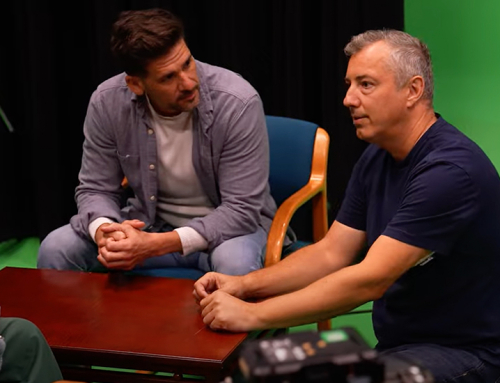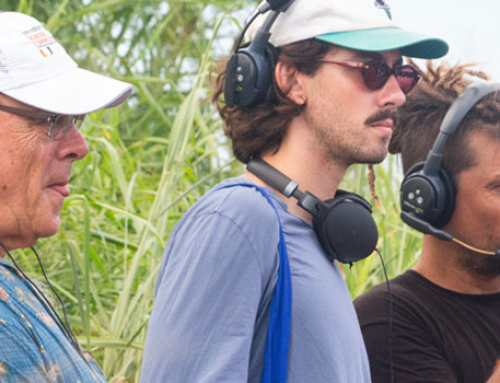By: Karina Valdes
When cinematic arts students were faced with challenges that could have prevented them from making a film, they adapted and used technology to connect globally and created their own opportunity.
“What if we made a film in China?” Ali Habashi, assistant professor of professional practice, asked the students in his fall 2020 CCA 351 class, Intermediate Filmmaking, through Zoom.
Habashi had 18 students in his online filmmaking class, with two students unable to leave China because of the travel restrictions in place due to COVID-19. In a regular semester, each student in CCA 351 assumes a role such as director or screenwriter, and they work together as a class to develop a film. This semester, Habashi was concerned his students would miss out on the important hands-on experience this course provides.
“We can do what everyone else does, you can watch a movie and write about it,” Habashi told his students, “or we can take this as an opportunity, and we can make a film online and shoot it in China.”
At that time, China had loosened its quarantine restrictions and people had more freedom to move around their cities. The plan the students came up with was to develop the script for the film titled SHU, audition actors in China, and scout locations, all through Zoom. They spent hundreds of hours working on the script; a process that took a month and a half. With the shoot taking place in China, the script had to be translated into Mandarin and adapted to the Chinese culture. The two students in China who were in the roles of director of photography and field producer, worked with the scriptwriters to translate the script and accurately reflect how a Chinese person in the situations in the film would react. These conversations between the students on both continents about culture also resulted in changes to props and locations.
“We actually went through 10 drafts of the script because we really made it a priority to make this a universal story that can happen anywhere, while tying in elements of Chinese culture in a non-stereotypical way,” said Sarah Topf, producer, co-writer, assistant director, and location scout for SHU and a double major in Motion Pictures Production and Spanish. “Our Chinese teammates, Kefan and Huxiangsu Luo, guided us on which areas of the story it was appropriate and authentic to add these elements to, which was a great learning experience.”
As the script was in its final stages, the class began its casting call. The students in China recruited actors and, together with the students in the U.S., spent hundreds of hours through Zoom auditioning potential actors.
At the same time, China began experiencing a resurgence of COVID-19 and some cities were blocked, preventing the students and actors from moving around the scouted locations.
“One of the actors couldn’t come to the city anymore, and had to be recast, so there were setbacks into filming because the pandemic in China was kind of setting things back in terms of mobility,” said Habashi.
The setbacks did not stop for the students.
“And then Shanghai changed, and they kind of blocked it and the students couldn’t go in and out at all anymore,” said Habashi.
The class had to adapt and re-scout locations around the city of Shanghai, as well as create a new storyboard. They also faced the challenge of working around a 12-, and at times 13-hour, time difference.
“During production, due to the time difference, our U.S. crews would have to stay up all night to participate in the production through Zoom,” said Kefan, director of photography and a Film Production major. “Our U.S. crews were taking turns to do that so that we always had someone on Zoom that was overseeing the style and reminding us of the director’s notes for each scene.”
Aside from the challenges caused by the pandemic, the students in China also needed professional equipment to film with.
“That’s where Fudan came in,” said Habashi. “One of our students who was in China knew one of the professors in Fudan University who is teaching film.”
That introduction started a collaboration between the two professors where they would teach their combined classes of about 70 students over Zoom, with the UM class starting at 9 a.m. and the Fudan class starting at 10 p.m.
“That created this kind of spirit of working together and they gave the equipment to our students in China,” said Habashi.
With a professional camera in hand, the students in China came up with a way of connecting a wireless transmitter from the camera to an iPad to Zoom.
“Whatever that camera in China was seeing, our students in Miami could see in real time,” said Habashi. “The director could tell the cameraman you know pan left or right or change the lens. When our students saw the camera live, they got super excited.”
In a typical production, the director doesn’t necessarily see what the cameraperson sees.
“Sometimes we have an external monitor, but normally the cameraperson looks through the camera and the director is looking directly at the actors, not through the camera,” said Habashi. But in this case, the director, the producer, and everybody on the team could see what the cameraperson could see during the shoot.”
The shoot took about six days to complete.
“I usually encourage my students to make films about human issues, and this was one of them. It’s about a 19-year-old girl who loses her mom and has to live with her grandma. She doesn’t want to live with grandma, but she has to. Grandma has lost her own daughter and she’s sad too. So, it’s about coming together to just share the sad experience they had,” said Habashi.
With SHU, the students in Habashi’s CCA 351 class gained hundreds of hours of hands-on experience working on an international film production, as well as an international film credit.
“This collaboration, expertly guided by Professor Habashi, demonstrates the commitment and talent of our students,” said Karin Wilkins, dean of the School of Communication. “Their process engaged simultaneous work across great spatial distance and time difference, culminating in an exquisitely rendered narrative of loss and connection, resonant across cultures.”
For students, the skills learned while working on SHU are critical to their education and career.
“This film has impacted my cinematic arts education and career because it taught me what it was like to work on an international film. I learned a lot about the Chinese culture and had the opportunity to meet talented people,” said Maria Calderon, art director for SHU and a General Motion Pictures major.
For Amanda Carballo, co-writer/editor for SHU and a Motion Pictures Production major, “being a part of the SHU crew was an amazing experience,”
“It really taught me the importance of communication, and organization, but also proved to me the possibilities are endless,” she added.
Although the film development came with many challenges, for the students, the shared experience of adapting to the unexpected has left them better prepared to face whatever may come their way.
“If I had any advice to anyone, it would be to not be scared to take on any challenges. I know it can be intimidating at first, but the experience is invaluable,” said Cinthya Franco, co-writer and director for SHU and an Electronic Media and Motion Pictures major.
As a result of working on this film while living in China, Kefan was inspired to work on another film with his friends abroad.
“As a student who spends my film education in the U.S., I have friended quite a few talented students in our School that I love to work with. Due to the COVID-19, I had to go back to China, and that leaves me with myself to make a film, said Kefan. “This production opened up the possibility for me to work with my friends in the U.S. Without the experience of making SHU, I would never have thought of such an idea.”
According to the filmmakers, SHU is the story of post-loss adaptation; the loss of a mother causes both the daughter and grandmother to live together under this newly forced and unwanted family dynamic. To view the trailer, visit https://vimeo.com/500652099. SHU is currently in post-production.
SHU Credits:
Written by: Amanda Carballo, Cinthya Franco, and Sarah Topf
Producer: Sarah Topf
Field Producer in China: Huxiangsu Luo
Director: Cinthya Franco
Director of Photography: Kefan
Editor: Amanda Carballo
Art Director: Maria Calderon










